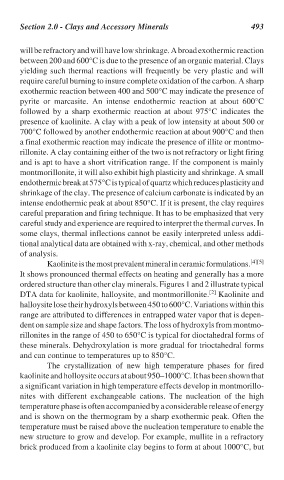Page 522 - Handbook of Thermal Analysis of Construction Materials
P. 522
Section 2.0 - Clays and Accessory Minerals 493
will be refractory and will have low shrinkage. A broad exothermic reaction
between 200 and 600°C is due to the presence of an organic material. Clays
yielding such thermal reactions will frequently be very plastic and will
require careful burning to insure complete oxidation of the carbon. A sharp
exothermic reaction between 400 and 500°C may indicate the presence of
pyrite or marcasite. An intense endothermic reaction at about 600°C
followed by a sharp exothermic reaction at about 975°C indicates the
presence of kaolinite. A clay with a peak of low intensity at about 500 or
700°C followed by another endothermic reaction at about 900°C and then
a final exothermic reaction may indicate the presence of illite or montmo-
rillonite. A clay containing either of the two is not refractory or light firing
and is apt to have a short vitrification range. If the component is mainly
montmorillonite, it will also exhibit high plasticity and shrinkage. A small
endothermic break at 575°C is typical of quartz which reduces plasticity and
shrinkage of the clay. The presence of calcium carbonate is indicated by an
intense endothermic peak at about 850°C. If it is present, the clay requires
careful preparation and firing technique. It has to be emphasized that very
careful study and experience are required to interpret the thermal curves. In
some clays, thermal inflections cannot be easily interpreted unless addi-
tional analytical data are obtained with x-ray, chemical, and other methods
of analysis.
Kaolinite is the most prevalent mineral in ceramic formulations. [4][5]
It shows pronounced thermal effects on heating and generally has a more
ordered structure than other clay minerals. Figures 1 and 2 illustrate typical
[2]
DTA data for kaolinite, halloysite, and montmorillonite. Kaolinite and
halloysite lose their hydroxyls between 450 to 600°C. Variations within this
range are attributed to differences in entrapped water vapor that is depen-
dent on sample size and shape factors. The loss of hydroxyls from montmo-
rillonites in the range of 450 to 650°C is typical for dioctahedral forms of
these minerals. Dehydroxylation is more gradual for trioctahedral forms
and can continue to temperatures up to 850°C.
The crystallization of new high temperature phases for fired
kaolinite and holloysite occurs at about 950–1000°C. It has been shown that
a significant variation in high temperature effects develop in montmorillo-
nites with different exchangeable cations. The nucleation of the high
temperature phase is often accompanied by a considerable release of energy
and is shown on the thermogram by a sharp exothermic peak. Often the
temperature must be raised above the nucleation temperature to enable the
new structure to grow and develop. For example, mullite in a refractory
brick produced from a kaolinite clay begins to form at about 1000°C, but

